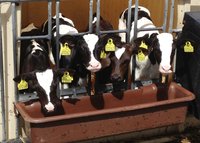Mortality among organic dairy calves to be reduced
An alliance of six organic farmers, two industrial partners and scientists from Aarhus University is set to develop new methods for the housing and management of calves to reduce the high mortality rate in organic cattle herds.

Far too many organic calves during their first weeks of life. They have a higher mortality rate than conventional calves, partly because they suffer more from diarrhoea during first weeks of life. A team of scientists from Aarhus University in Foulum will try to identify the causes and in collaboration with six farmers and two industrial partners develop new methods and recommendations so that more calf lives can be saved.
- The high calf mortality is a major challenge, or perhaps even a threat to the organic dairy producers’ reputation, says Jan Tind Sørensen, who is Section Manager Professor at Aarhus University in Foulum. He is the leader of the new research project ViOrCa, which has just been granted two million Danish kroner from the Green Development and Demonstration Programme. The industrial partners are SEGES and Calvex.
- Organic milk accounts for a third of all milk sales, and one of the reasons so many consumers are willing to pay a premium price for organic milk is because they expect a high animal welfare. The high calf mortality can challenge the positive perception of the organic production, even though welfare is much more than just the mortality rate," he points out.
More organically reared calves die
The high mortality rate for calves reared in organic dairy herds is documented by SEGES. On an annual basis 9.4 per cent of calves in organic dairy herds die in the first six months compared with 8.2 per cent for conventional practices. When looking at the first 30 days only, the difference is even more pronounced, namely 5.7 per cent compared with 4.7 per cent for the conventional herds.
- We do not know for sure what the cause of this is, but results fra a Masters’ student dissertation comparingconventional and organic herds showed more diarrhoea in organic herds. We will therefore focus on three areas where special regulations apply to organic practices and where these practices may influence the incidence of diarrhoea, explains Jan Tind Sørensen.
The organic calves stay with their mothers for the first 24 hours, they are grouped with other calves when they are one week old and they are fed cow’s milk for the first 13 weeks – these rulesaiming at providing good for calf welfare, but may also cause diarrhoea if management practices are not adjusted to the conditions.
Experiments in six herds
Scientists and farmers will over the next two years examine whether the infection pressure will become less if (a) the organic calves are given a supplement of colostrum in their first few hours of life from cows with a very good immune status, (b) calves are penned in twos rather than in large groups and (c) pasteurisation of the cow’s milk fed to organic calves can improve milk hygiene so significantly that problems with diarrhoea can be reduced.
- I think that milk hygiene and group housing play a major role in the high incidence of diarrhoea, but the fact that the calf stays with its mother for longer may also be a contributing factor, says Jan Tind Sørensen.
- It can put you into a false sense of security that you have seen the cow and calf together and have seen the calf drinking at some time or other. But this is not a guarantee that it has received sufficient colostrum within the first six hours where the concentration of antibodies in the milk is the highest – and if the calf does not get its colostrum, its immune system may be compromised, he explains.
A solution to that problem might be to freeze colostrum from cows with a good immune status and to give each calf the high-standard thawed colostrum in its first few hours of life.
The six herds that are included in the project are the subject of experimental tests in all three areas, and the effect on the incidence of diarrhoea, respiratory infections and mortality rate will be measuredcontinuously monitored. After two years, the project will lead to new recommendations for housing, milk hygiene and colostrum supplementation in organic herds.
Further information
The ViOrCa project is part of the Organic RDD 2.2 programme, which is coordinated by ICROFS
(International Centre for Research in Organic Food Systems).
The project is funded via the Green Development and Demonstration Programme under the Ministry of Environment and Food.
Contact
Section manager and professor Jan Tind Sørensen
Department of Animal Science
Mail: jantind.sorensen@anis.au.dk
Telephone: +4587157923
Mobile: 20783343
